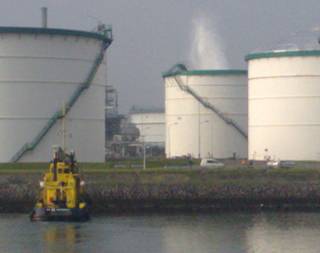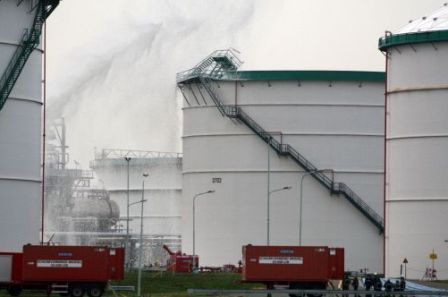
Report
Subject: Rotterdam Sunken Roof - Royal Vopak NV Naphtha Tank Date of Email report: Mon 03/11/2008 Report Detail:
Rotterdam Unified Industrial Harbour Fire Department on protective stand by at Royal Vopak NV. The 34m diameter Naphtha tank roof sank on Friday morning. The tank roof is being stabilised by a balanced water injection at the base in conjunction with Naphtha recovery over the top. Some 21,000m3 of Naphtha is being removed in order for the repairs to be effected which may take up to 3 days to complete. The Naphtha vapours are being suppressed using fire-fighting foam. Note the gauging platform which has been severely bent inward due to the tank roof movement and connection to access ladder ``The situation is stable and now we are trying to pump the naphtha out,''Lars Walder, a spokesman for Rotterdam-based Vopak, said today in a telephone interview. Walder said no injuries were reported. He couldn't comment on what caused the roof to fall. Vopak's Europoort terminal consists of 95 tanks with a total storage capacity of about 3.3 million cubic meters. The site has berths for as many as seven vessels, according to the company's Web site. Work at the terminal has been halted and isn't expected to resume today, Walder said. Four ships are now waiting to deliver or load products at the terminal and other vessels have been diverted to other sites, Walder said. Ships elsewhere in the port area aren't affected by the incident, said Tie Schellekens, a spokesman for the Rotterdam Port, by telephone. In 2006, Vopak together and the port expanded the terminal and began building a jetty to keep pace with rising oil volume. |


